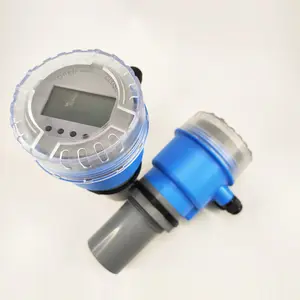
Ultrasonic Level Meter Atech Water Liquid Ultrasonic Tank Level Meter Ultrasonic Level Transmitter Ultrasonic

Ultrasonic Lever Transmitter General Purpose Liquid Ultrasonic Level Sensor Safe 4-20 MA Output Ultrasonic Level Meter






An integrating sound level meter is a precision instrument engineered to gauge sound pressure levels with exactitude. It employs cutting-edge technology to calculate an average sound level over a designated timeframe, a critical function for a host of industrial and environmental uses. These devices play a pivotal role in gauging noise pollution and adhering to auditory regulations.
Varying models of integrating sound level meters serve diverse requirements and uses. Industrial-grade meters are crafted for resilience and prolonged operation in rigorous conditions, whereas DIY versions are suited for occasional or amateur usage. Certain meters are specialized for high-decibel industrial settings, while others are customized for more subdued environments such as offices or healthcare facilities. The complexity of these instruments ranges from simple noise level indicators to those offering comprehensive frequency analysis and data logging features.
The architecture of an integrating meter is thoughtfully designed. Central to its operation is the microphone, tasked with capturing acoustic waves. These are transformed into electrical impulses by the transducer, then refined by electronic circuitry that applies requisite time-weighting and integration. The resultant data is exhibited on a digital interface, with options to archive or export findings for subsequent examination. Select models may also incorporate ancillary elements such as external memory slots, navigational controls, and ports for additional apparatus.
Materials chosen for an integrating sound level meter prioritize durability and acoustic performance. Robust yet lightweight plastics form the device's exterior, ensuring it can endure the demands of field use. Internally, conductive metals and alloys are utilized for their conductive properties and environmental resilience. These material selections guarantee the meter's longevity, dependability, and measurement precision.
Integrating sound level meters are essential in sectors where noise is a significant factor. In the realm of construction, they aid in monitoring ambient noise to safeguard workers' auditory health. In manufacturing, they verify that equipment noise remains within safe thresholds. Within the entertainment industry, they regulate sound at events to adhere to local sound ordinances. These meters are instrumental in upholding health and safety protocols, as well as in helping enterprises evade penalties and foster an acoustically agreeable atmosphere.
The fundamental role of an integrating averaging sound level meter is to precisely quantify sound pressure levels over time. This encompasses capturing peak and trough levels, as well as computing equivalent continuous noise levels. More sophisticated functions may include frequency weighting, adjusting the meter's responsiveness to various frequencies to reflect the human ear's auditory response.
Salient attributes of an integrating sound level meter may encompass an illuminated display for dim conditions, data logging for retrospective analysis, and wireless connectivity for distant observation. Certain meters are compatible with software for enhanced data scrutiny, augmenting their practicality. These characteristics distinguish them from basic noise meters and offer additional benefits for users needing in-depth acoustic evaluations.
The advantages of employing an integrating meter include heightened precision in noise exposure assessments, fostering more informed decisions regarding noise abatement strategies. This can culminate in a more salubrious work setting, legal compliance, and improved employee productivity by mitigating noise-related stress.
To deploy an integrating sound level meter efficaciously, one must comprehend the specific acoustic demands of the intended environment. Calibration is paramount for accurate measurements, followed by the selection of suitable settings for the noise level and character. Routine inspections and recalibration are advised to preserve measurement fidelity.
Opting for the appropriate integrating averaging sound level meter entails evaluating the environment of use, the nature of the noise to be measured, and the desired detail in the readings. Factors such as user-friendliness and manufacturer support for calibration and upkeep should also be taken into account.
To clean and maintain an integrating sound level meter, one should gently wipe the exterior with a soft, lint-free cloth, steering clear of abrasive chemicals that could harm the materials. The microphone must remain clear of obstructions and contaminants, and storing the device in a protective case when not in use is recommended to safeguard its sensitive components.
Setting up an integrating sound level meter is generally a straightforward process, involving the attachment of the microphone and any supplementary parts, then initiating the device and adjusting the settings. Certain models might necessitate the installation of accompanying software on a computer for data analysis.
The intended users of integrating sound level meters span professionals in construction, manufacturing, environmental surveillance, as well as event coordinators and safety regulators. These instruments fulfill the needs of such professionals by delivering precise and dependable noise measurements, crucial for maintaining safe and compliant sound levels.
Essential features to consider include an extensive dynamic range, adherence to international norms, data logging functionality, simplicity of operation, and the availability of customization options to meet specific measurement requirements. Moreover, the microphone's quality and the stability of its calibration are vital for accurate assessments.
An integrating sound level meter bolsters workplace safety by offering precise noise exposure readings, enabling employers to implement efficacious noise control strategies. This contributes to the prevention of auditory damage and the maintenance of a comfortable and secure work environment for staff.
Indeed, integrating sound level meters are well-suited for environmental noise evaluation. They facilitate the assessment of noise pollution over time, assisting in the formulation of sound reduction plans and ensuring that environmental noise remains within prescribed limits to safeguard community health and comfort.